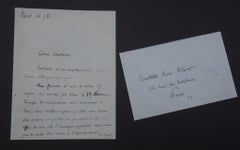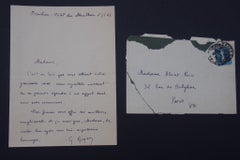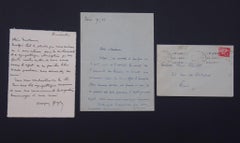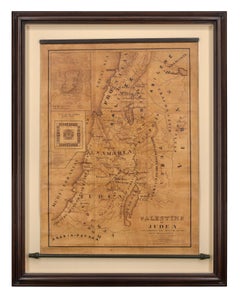Georges Goyan Art
to
3
Overall Width
to
Overall Height
to
3
2
1
3
3
3
3
9,475
2,687
1,375
1,358
3
Artist: Georges Goyan
Apology Letter Signed by Georges Goyan - 1920s/1930s
By Georges Goyan
Located in Roma, IT
This Autograph is an Apology Letter Signed by Georges Goyan to the Countess Pecci-Blunt.
Not dated. Paris, 20/II. Around 1920s-30s. On light blue-colored and laid paper. In French. ...
Category
1920s Georges Goyan Art
Materials
Paper, Ink
Autograph Greeting Letter Signed by Georges Goyan - 1923
By Georges Goyan
Located in Roma, IT
This is a Autograph Greeting Letter Signed by Georges Goyan to the Countess Pecci-Blunt.
Arcachon, January 5th, 1923. On ivory-colored and laid paper. In French. One page, single-si...
Category
1920s Georges Goyan Art
Materials
Paper, Ink
Autograph Apology Letters Signed by Georges Goyan - 1936/1937
By Georges Goyan
Located in Roma, IT
These are two Autograph Apology Letters Signed by Georges Goyan to the Countess Pecci-Blunt.
Paris, July 5th, 1936. Written on behalf of G. Goyan, likely by his wife H. Goyan, One pa...
Category
1930s Georges Goyan Art
Materials
Paper, Ink
Related Items
Map of Palestine or Judea, Illustrating the History of the New Testament
By Rev. Nathan B. Rogers
Located in New York, NY
Pen and ink on paper, laid down on canvas, mounted to wooden scroll bars
Signed and dated lower right: “Drawn by N. B. Rogers August. 1843”
Inscribed with an ownership inscription on the verso: Rev. E. D. Daniels, Palmer, Mass.
Provenance:
Rev. Eugene Davidson Daniels, Palmer, Massachusetts, 1871
This extraordinary manuscript map is a rare survivor of the devotional and educational culture of New England in the first half of the nineteenth century. Although at first glance resembling a large-scale engraving or printed publication, this precisely rendered wall map was entirely drawn by hand, the product of meticulous research by a minister working in isolation in rural Maine. The map shows New Testament era cities, towns, tribal areas, and political borders as well as physical features such as rivers, lakes, mountains, and hills (indicated by half-tone cross-hatching). On to this geographically accurate rendering of the Holy Land, Rogers has located and inscribed significant locales mentioned in the Gospels and has annotated these places with relevant citations from the Bible. He further records these by plotting the travels of Jesus on what resemble a series of trails across the Holy Land. Each is distinguished by a different pattern of dots and dashes – correlated to an explanatory table at the lower right. From this we know that these lines document the “Flight into Egypt and return,” “Travels of Christ from Nazareth to Jerusalem and return,” “Travels from the commencement of his Ministry to the first Passover,” “Travels from the first and the second Passover,” “Travels from Jerusalem to Galilee after the 2nd Passover,” and “Travels from the third Passover to the Crucifixion.”
An inset map of “Jerusalem...
Category
19th Century Georges Goyan Art
Materials
Canvas, Paper, Ink, Pen
Citroen 15CV - Contemporary Watercolor & Ink Painting, Vintage Car, Realistic
By Mariusz Szałajdewicz
Located in Warsaw, PL
Mariusz Szalajdewicz (b. 1974)
Studied at the Faculty of Architecture at Warsaw University of Technology, where he mastered the drawing skill. Architect and urbanist, illustrator.
Category
21st Century and Contemporary Realist Georges Goyan Art
Materials
Paper, Ink, Watercolor
$235 Sale Price
20% Off
H 11.42 in W 15.75 in
Mercedes W18 - XXI Century, Contemporary Watercolor & Ink Painting, Vehicle, Car
By Mariusz Szałajdewicz
Located in Warsaw, PL
Mariusz Szalajdewicz (b. 1974)
Studied at the Faculty of Architecture at Warsaw University of Technology, where he mastered the drawing skill. Architect and urbanist, illustrator.
...
Category
21st Century and Contemporary Realist Georges Goyan Art
Materials
Paper, Ink, Watercolor
$235 Sale Price
20% Off
H 11.82 in W 16.15 in
The philosophy of Andy Warhol
By Andy Warhol
Located in Jerusalem, IL
A book by Andy Warhol. Signed and sketched by the artist on the first page of the book.
Signed on the bottom of the first page.
The Philosophy of Andy Warhol (From A to B & Back Aga...
Category
1970s Pop Art Georges Goyan Art
Materials
Paper, Ink, Permanent Marker
Giardino di Rose
Located in Mokena, IL
Giardino di Rose, 2022
Ink on Toned Paper with Frame, 12.25 x 15.25 inches
Transporting the viewer to Florence’s sun-lit rose garden, Justas Varpucanskis...
Category
21st Century and Contemporary Contemporary Georges Goyan Art
Materials
Ink, Handmade Paper
"The Embrace (Shunga Study), " Mixed Media Collage
By Michael Thompson
Located in Chicago, IL
Based in Chicago, IL, contemporary artist Michael Thompson creates unique kites, collages and mixed media works assembled from material fragments of past and present collected in his...
Category
21st Century and Contemporary Abstract Georges Goyan Art
Materials
Paper, Ink
$3,280
H 15 in W 19 in D 1.5 in
Ex Libris 1982, paper, ink, gouache, 17.5х13 cm
Located in Riga, LV
Ex Libris
1982, paper, ink, gouache, 17,5х13 cm
Information about artist:
Gunārs Vīndedzis (1918 - 1991) - cartoonist, illustrator.
Born in a fami...
Category
1980s Realist Georges Goyan Art
Materials
Paper, Ink, Gouache
$283 Sale Price
20% Off
H 6.89 in W 5.12 in D 0.08 in
Antique Manuscript Map - Forest of Andely
Located in Houston, TX
Charming hand drawn ink and watercolor map of the Forest of Andely, in the Normandy area, France, circa 1890.
Original artwork on paper displayed on...
Category
1890s Georges Goyan Art
Materials
Ink, Paper, Watercolor
Royalty, 60x49cm, acrylic/ink/paper
Located in Yerevan, AM
The work is sold without a frame and mat
Category
2010s Georges Goyan Art
Materials
Paper, Ink, Acrylic
Space Invader Prints On Paper Art Book Prints 2001 - 2020 Limited Edition Street
By Invader
Located in Draper, UT
Limited Edition Street Art France, 2021
Hardcover Book
10 1/2 × 8 × 2 in
26.7 × 20.3 × 5.1 cm
Edition of 3000
This work is part of a limited edition set.
Medium
Books and Portfolio...
Category
Early 2000s Street Art Georges Goyan Art
Materials
Paper, Archival Ink
$1,000
H 10.5 in W 8 in D 2 in
Welcome ... 1994. Paper, ink. 18x25.3 cm
Located in Riga, LV
Welcome ...
1994. Paper, ink. 18x25.3 cm
Illustrated in the magazine "School and Family" in 1994.
Category
1990s Modern Georges Goyan Art
Materials
Paper, Ink
$169 Sale Price
20% Off
H 7.09 in W 9.97 in D 0.04 in
School 1994, paper, ink, 15.2x19 cm
Located in Riga, LV
School
1994, paper, ink, 15,2x19 cm
Illustrated in the magazine "School and Family" in 1994.
Category
1990s Modern Georges Goyan Art
Materials
Paper, Ink
$169 Sale Price
20% Off
H 5.99 in W 7.49 in D 0.04 in
Georges Goyan art for sale on 1stDibs.
Find a wide variety of authentic Georges Goyan art available for sale on 1stDibs. You can also browse by medium to find art by Georges Goyan in ink, paper and more. Not every interior allows for large Georges Goyan art, so small editions measuring 5 inches across are available. Georges Goyan art prices can differ depending upon medium, time period and other attributes. On 1stDibs, the price for these items starts at $267 and tops out at $339, while the average work can sell for $267.




